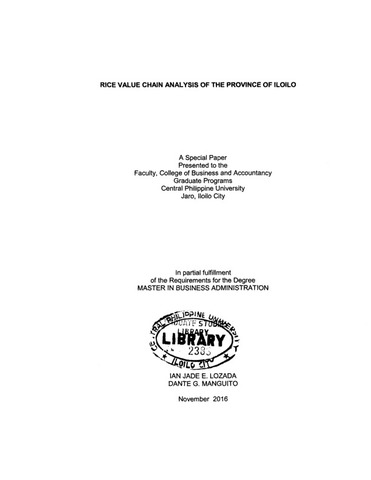Rice value chain analysis of the Province of Iloilo

Page views
1,432Date
2016Thesis Adviser
Defense Panel Chair
Share
Metadata
Afficher la notice complète
Résumé
This study was conducted to analyze the Rice Value Chain of the Province of Iloilo. Specifically, the study aimed to: 1) trace the rice value chain and identify the significant roles of the value chain actors; 2) to determine how value was created along the chain; 3) to determine the strengths, weaknesses, opportunities and threats in the value chain; and; 4) to provide the possible improvements or interventions to strengthen the rice value chain of the Province of Iloilo. The study is a descriptive research that utilized structured questionnaires; guideline-based interviews; workshops that includes transect walks and services; opportunities map; and lastly, focus group interviews to triangulate and validate the result gathered. Purposive sampling technique was used using aggregated data at LGU-level and unweighted index of average ranks per criteria per LGU used to select more advantageous and more disadvantageous LGUs. This together with a sampling for diversity on barangay-level, also based on their agricultural profiles, aimed to cover the variety of existing market access situations. Selection of barangays was based on the prerequisite site that the sample of barangays per LGU include irrigated and rain fed farms, small to large, as well as short and long travel time to trading hubs. Interviewed farmers covered the wide variety of production contexts. This was achieved through sampling of LGUs and barangays. At the top of the value chain is the farm household, which exerts labor for rice production to be possible and has the most crucial role. Although farmers have the most number of responsibilities in the value chain, they are the ones who are least powerful for they cannot dictate the price for their produce which is the palay. Value of the chain starts with the farmers selecting the rice variety and land preparation and it ends with the consumers eating and enjoying rice and its benefits on their tables. In between the chain is the miller who processes palay into rice and sells it either directly to the consumer, wholesaler and retailers. Wholesalers and retailers are needed in order for rice to reach a wide scope of the consumers. SWOT analysis was done in order to determine the strengths, weaknesses, opportunities and threats of the value chain that will identify possible improvements or intervention that will strengthen the rice value chain in the Province of Iloilo. Based on the foregoing analysis, the farmers have the most significant role in the rice value chain in the province of Iloilo. Thus, government support, efforts and enhancement must be strengthen and focused for this actor to achieve sufficiency. Therefore, RBFH and government supporters must work hand and hand to uplift the condition of the Rice Value Chain in the province to make it better and beneficial to the farmer.
Description
Abstract only
Suggested Citation
Lozada, I. J. E. & Manguito, D. G. (2016). Rice value chain analysis of the Province of Iloilo (Unpublished Master's special paper). Central Philippine University, Jaro, Iloilo City.
Type
Special paperSujet
Keywords
Department
School of Graduate StudiesDegree
Master in Business AdministrationShelf Location
GSL Theses 650.072 L959
Physical Description
xii, 109 leaves




